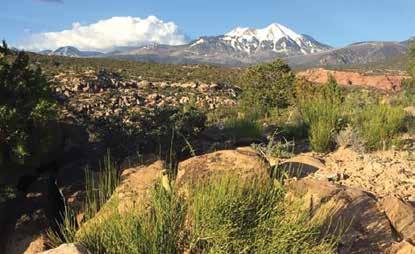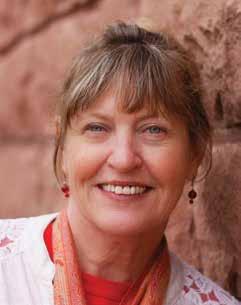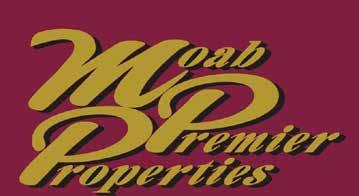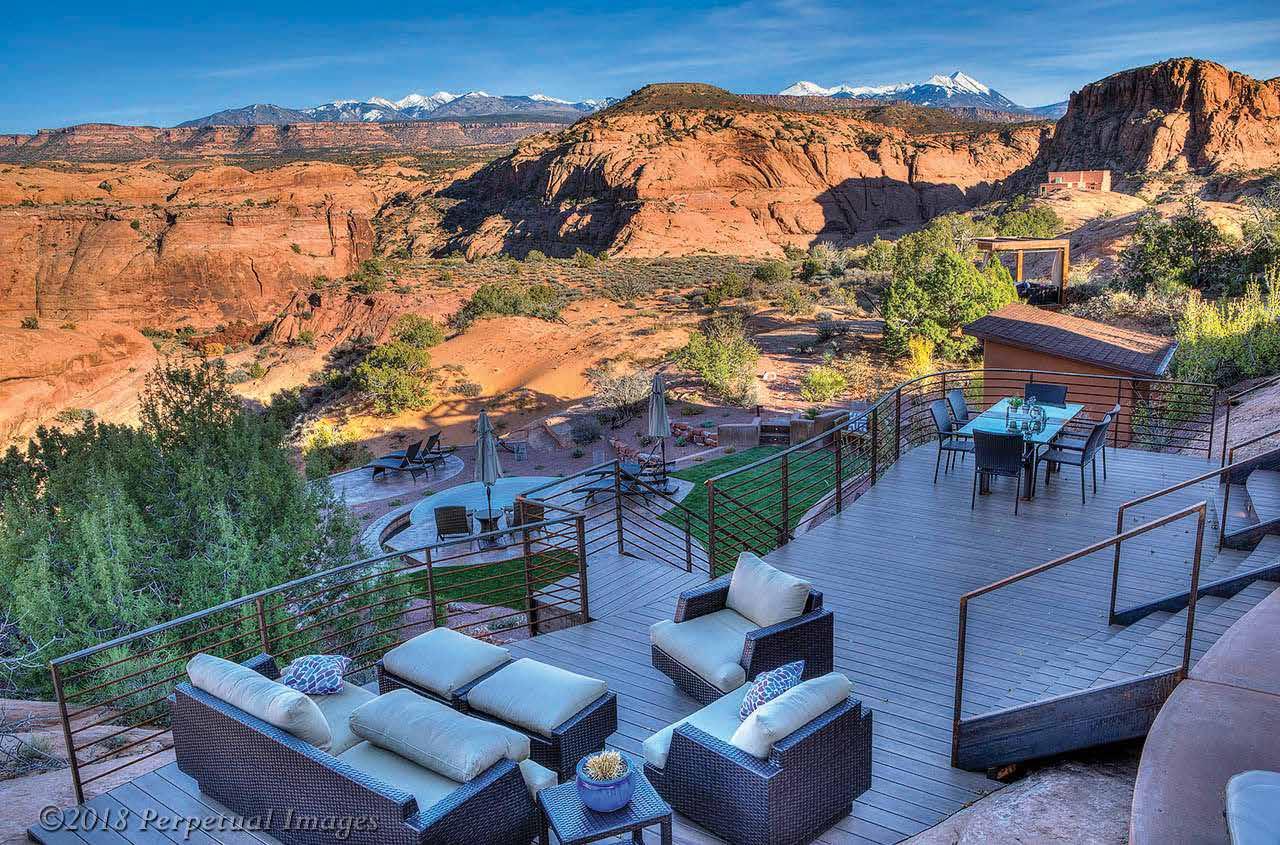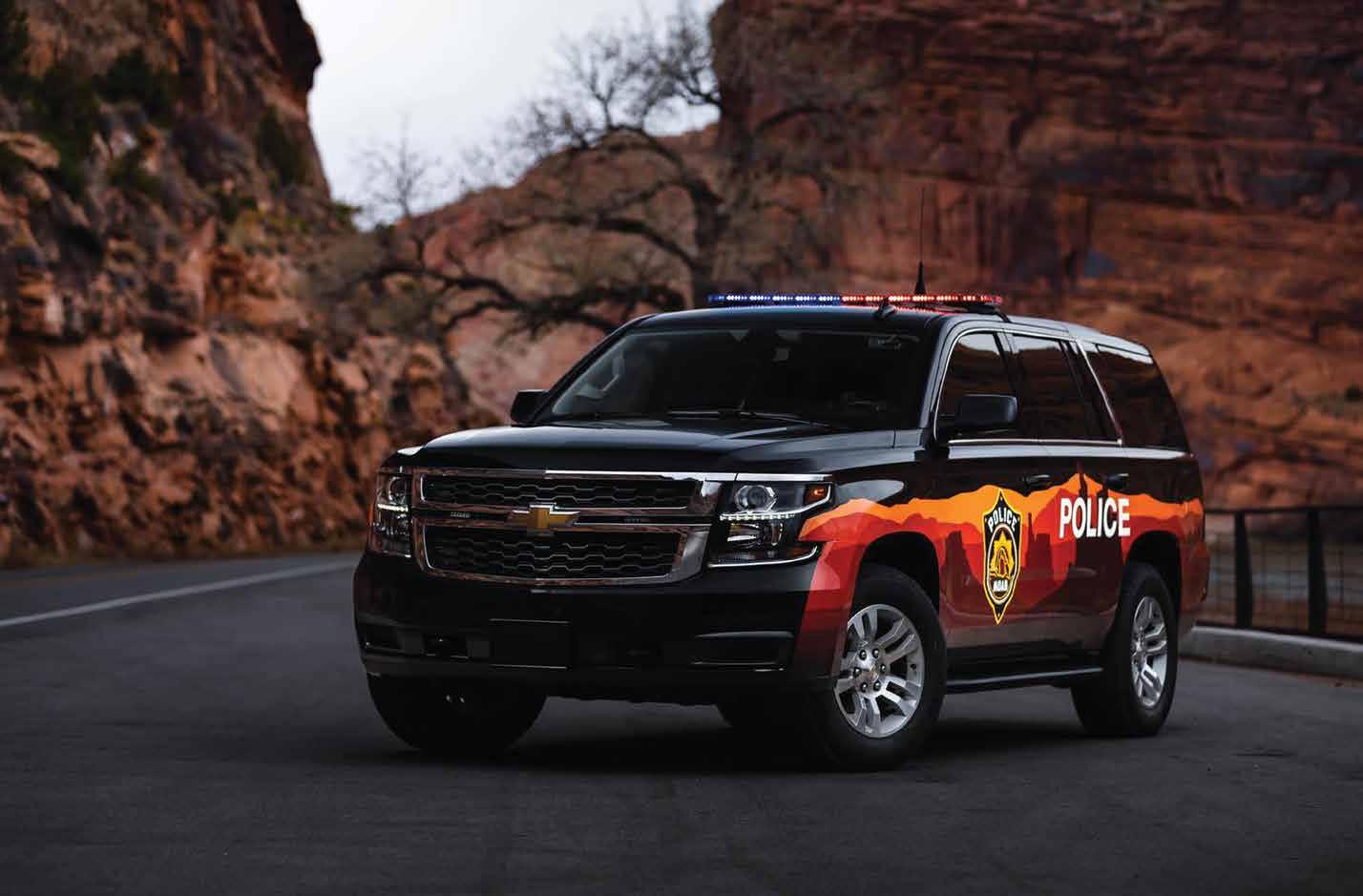
12 minute read
Serving and protecting the community
SERVING AND PROTECTING MOAB Chief Bret Edge leads a respected and community-focused police department into the next decade
Written by Rachel Fixsen | Photos by Murice D. Miller
“T he truth can be stranger than fiction in this job,” Moab Police Officer Larry Velasquez told me as I rode along with him on one of his Friday evening patrol shifts, quoting the officer who trained him. The truth in this instance was that Moab was fairly quiet. Velasquez gave a stern reminder to one motorist that Utah law requires drivers to move over for law enforcement pulled over on a roadway. He stopped to assist someone trying to start a stalled pick-up truck. He responded to a call about a vehicle parked in a public lot; the caller had noticed that the car’s door had been open for over an hour, with no owner in sight.
Velasquez was born and raised in Moab. He left town to attend school and considered a couple of career paths before returning to Moab and entering law enforcement. He worked for one year for Grand County as a jail guard, but found that the routine of the position wasn’t for him. He joined the Moab Police Department four years ago. As a patrol officer, he says, no two days are the same.
The MPD’s Police Chief, Bret Edge, agrees. “It varies wildly,” Edge says when asked about a ‘typical’ patrol shift. “It depends on whether it’s winter or in season; it depends on if it’s a weekday day or a weekend night.”
CHIEF BRET EDGE Edge has been on the Moab police force for thirteen years, first as a patrol officer, then as a patrol sergeant, then as assistant police chief, and, as of last year, as the department chief. Before moving to Moab, Edge worked as a stockbroker in Phoenix and later in Denver. When he lived in Phoenix, his roommate worked on the local SWAT team, and when Edge picked up his briefcase to go to work in the mornings and watched his friend leave for work with his police gear, he thought “‘Hey, your job’s a lot cooler than mine.’”
When Edge was laid off from his job in finance thirteen years ago, he and his wife Melissa decided it was an opportunity to try a different pace of life. Both had always lived in big cities; they wanted to be in a place “where we could walk out our back door and go for a trail run, go mountain biking or go hiking,” he says.
Edge applied to the police department, nudged not only by the memory of his friend in Phoenix but also by the influence of his father, who was deputy sheriff in Los Angeles for twenty years. He hasn’t looked back.
- Rhiana Medina, Executive Director, Moab Valley Multicultural Center
He and his wife are enjoying raising their son, Jackson, in Moab. They love the outdoor recreation opportunities and the spectacular scenery, which was a frequent subject of Edge’s professional photographs, a second career he maintained in Moab before he became chief of the department. It’s not just Moab he appreciates, but also law enforcement.
“I love it,” Edge says. “Best job I’ve ever had... It sounds really cliche to say it, but you get to go home at the end of the day and you know that you’ve made an impact.”
A MODERN DEPARTMENT The department has undergone somewhat of an evolution in recent years. After highly publicized allegations of misconduct against two MPD officers several years ago, the City brought in Jim Winder, a seasoned leader in law enforcement, from Salt Lake City, to act as chief. Winder was with the department for two years before returning to Salt Lake; Edge succeeded him as chief.
“The department lacked the structure necessary to properly deal with those types of incidents,” Edge says. “One of the things that [Chief] Winder did when he got here was recognize that we needed a more robust internal affairs program… So one of his initial priorities was to get those types of programs up and running—which he did.” Edge says that, in some respects, the culture at the MPD has made a “complete one-eighty.”
Now, Edge says, “When people make a mistake, we hold them accountable—you have to.” He says helping correct an employee’s behavior when mistakes are small can prevent more significant incidents. “If there are small issues, we deal with them right away so that they don’t become bigger issues,” he says.
Another change at the department has been the establishing of a Victims Assistance Unit. The unit is funded by the U.S. Department of Justice through the Victims of Crime Act. Karen DeKruger is the Moab Police Department victims’ advocate. She says she is often the first point of contact for victims of crime with the county and city prosecution systems.
“I notify victims of court proceedings regarding their cases and accompany them to court,” DeKruger explains. “Victims have the right to speak at sentencing, so I will help them prepare for that as well. I stay with them throughout the court process and for any additional time they need.” She can also help victims obtain protective orders or stalking injunctions against an alleged perpetrator.
The Victims Assistance Unit can also provide victims of crime with funding for emergency lodging, fuel, transportation, food, and
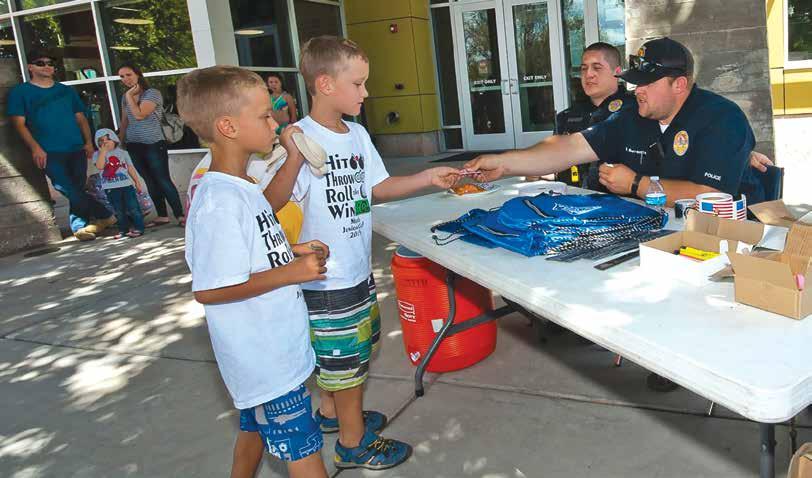
Opposite page: Moab Police Department’s newest vehicles, 2020 Chevrolet Tahoe Special Service Vehicles, include special law enforcement enhancements like upgraded suspension, high-capacity batteries to power auxiliary equipment, high-output alternators, and built-in inverters to power laptops and other devices. [Photo by Miguel Angel / Courtesy Moab Police Department] Top right: Moab Police Department Chief Bret Edge. Bottom left: From Left to right, Officer Monty Risenhoover and School Resource Officer Ryan Burraston at the Community BBQ & Swim Day.
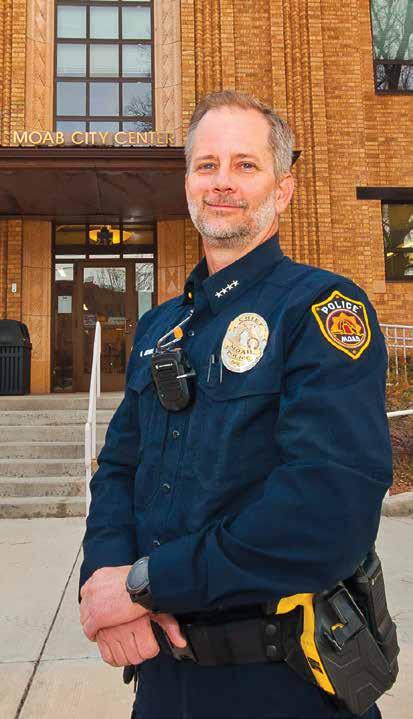
clothing, and can refer them to organizations to help them with long-term housing solutions or with counseling and mental health services.
“She’s extremely busy,” Edge says of DeKruger. “Last year there were well over 150 victims served. It’s a good service to have—I’m glad that we have it—but it’s unfortunate that it’s necessary.” The department hopes to be able to hire another staff member part-time to assist DeKruger, and is exploring opportunities to use volunteers.
The department has also had to adapt as the City of Moab has grown and changed. They’ve upgraded their radio and body camera technology, and are striving to keep up with the quickening pace of life in Moab.
“Our call volume has gone up,” says Edge. “It’s just really gotten busier for us.” He says they would like to grow their force to employ twenty-five officers; right now they have seventeen, and budget constraints won’t allow for new positions. However, Edge says the department is able to retain officers longer thanks to newer incentive programs.
“For the first time in as long as I can remember, we don’t have any openings for police officers,” Edge says.
PARTNERSHIPS The MPD works with many other organizations with complementary or overlapping missions. They partner with neighboring law enforcement agencies like the Grand County Sheriff’s Office and Utah Highway Patrol. They also sometimes operate alongside Emergency Medical Services. They work closely with Seekhaven Family Crisis and Resource Center, a local nonprofit that serves victims of domestic
violence and sexual assault. This past year, employees from both Seekhaven and the MPD participated in a “Lethality Assessment” training, studying ways to assess the risks of a domestic situation when they are called to a scene.
“They have an awesome program and some really fantastic employees. We’re thrilled to be able to partner with them,” Edge says of Seekhaven.
The Moab Valley Multicultural Center (MVMC) is another community nonprofit that works with the police department.
“The Multicultural Center and the Moab Police Department have a fantastic collaborative working relationship,” says Rhiana Medina, executive director of the center. “It’s an honor to be supportive of Chief Edge as he has stepped into this new leadership role.”
Advocates from the MVMC assist people as they navigate the court system in civil cases, helping them understand their rights. Medina says MVMC advocates work on a variety of issues, including homelessness, mental health issues, and addiction; these same issues may bring individuals into the realm of the police department.
“We’re really interested in the same outcome as law enforcement—and that is … a happy, safe,

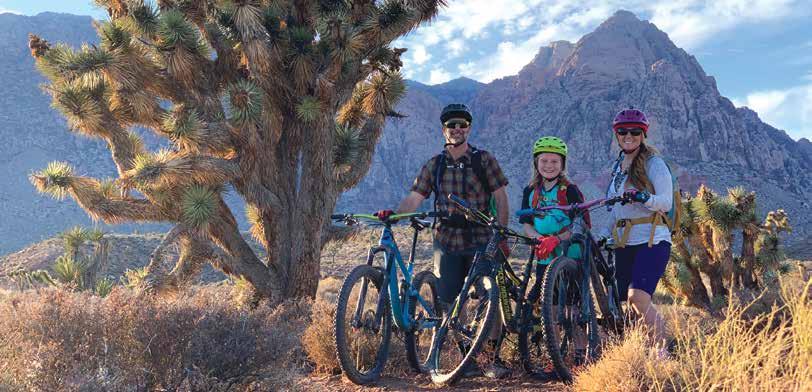
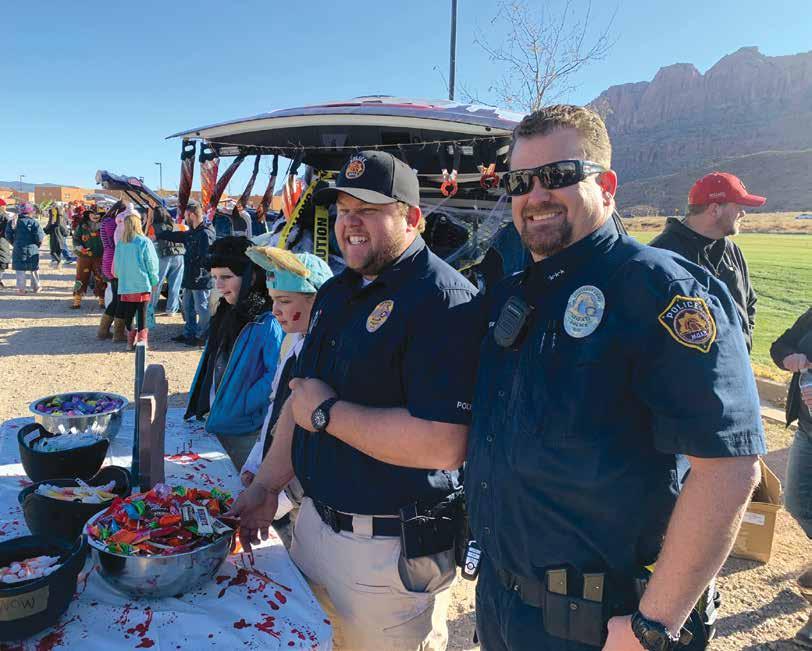
and healthy community,” says Medina. “We have a lot in common and a lot of reasons to work together.”
Medina says she appreciates Edge’s willingness to work with her organization. “Chief Edge is really community oriented,” she says. She also commends non-law enforcement personnel at the department.
“He’s got a really fantastic administrative staff,” Medina says of Edge. “They’re really helpful to our office as well.”
The department also works with the local school district. School Resource Officer, Ryan Burraston, handles crimes that occur on school district grounds, and also works with Grand County public schools on anti-bullying programs. Grand County High School principal Steve Hren has high praise for the MPD’s role on campus. “Our School Resource Officer does an amazing job helping us with investigations of theft, vandalism, and monitoring student driving while on campus,” he says, adding that Burraston also helps to address issues like students vaping on campus.
For the past two years, Burraston has also offered a Criminal Justice course to Grand County High School students. The course is open to all grade levels, but Hren says that mostly juniors and seniors sign up for the class.
Hren notes that the course helps encourage students with an interest in law enforcement. “In fact, several of our local city officers are alumni of GCHS,” he says.
Edge agrees the MPD values those connections with students forged through the school resource officer program. “For us it’s also just a really good way just to be more involved in the community, and especially the younger community, and build some of those relationships,” he says.
From left to right, Sergeant Jason Boots, Officer Monty Risenhoover, Chief Bret Edge and Assistant Chief Mike Thurston.
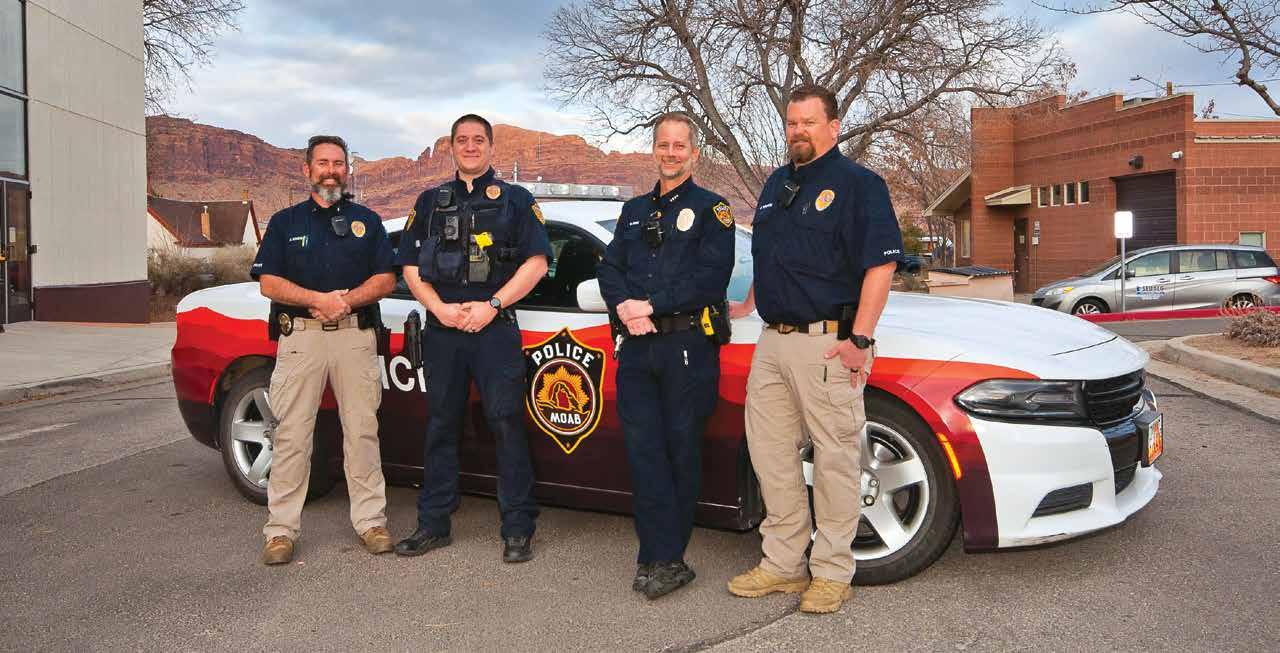
“I always tell the guys, if you’re ever having a bad day, go to the elementary school. You’ll get hugs and high fives and questions — it will turn your day around every single time.” - Moab Police Chief Bret Edge Edge says that his officers find that they can get as much back from the schools as they provide in services.
“I always tell the guys, if you’re ever having a bad day, go to the elementary school,” Edge says. “You’ll get hundreds of hugs and high fives and questions, it will turn your day around every single time.” LIFE AS A COP MPD officers are constantly training, learning new policies and skills, and refreshing the skills they’ve learned before. The department is mandated to provide at least forty hours of training per year per officer; Edge says his officers usually complete more than double the minimum required hours of training. All officers attend an annual legal update, in which state representatives present an overview of changes in laws and how they’ll affect enforcement officers. They also have a firearms training three times a year, emergency vehicle operations training every other year, and various other trainings like defensive tactics, investigative skills, and how to clearly and thoroughly document and report specific kinds of crimes.
“We have a healthy training budget, thankfully, and we do send officers out to training out of town,” Edge added. The department makes an effort to send each of their officers to Special Weapons and Tactics (SWAT) school in Colorado Springs.
A patrol officer might spend a shift responding to calls, monitoring traffic, following up on investigations or reports, or on bike or foot patrol. “Getting out on bike patrol is awesome,” says Edge, who loves mountain biking in his off time as well. “For the most part, when you’re out on bike patrol or foot patrol, your contacts are positive,” he adds. Families will stop to chat; cops will hand out stickers to kids and pose for photos with tourists while providing a presence on foot or bike patrols. During a vehicle patrol, calls can run the gamut from benign to dangerous. On a brief ride-along with Moab Police Officer Thomas Talbert, Talbert gave a warning to a driver with expired registration, administered a breathalyzer test to an individual on parole, de-escalated a conflict between a father and his teenage son, and identified and returned a lost backpack to a young Moab resident.
Talbert is from Delta, Utah, and moved to Moab four years ago to join the police department. He enjoys the work, though it isn’t always as tame as the shift described above. In 2017, he was part of a response team that responded to a gunman at the Rio Bar and Grill. “Deputy Brewer and Officer Talbert made initial contact with the subject and were responsible for physically removing the gunman from the bar, taking him to the ground outside the busy establishment where the subject was able to fire one shot from a semi-automatic handgun,” read a Moab Police Department Facebook post about the incident at the time.
“I found out I don’t like being shot at,” Talbert says of the experience. Winder formally recognized the officers’ courage soon after the incident occurred.
“These men are heroes and our community is fortunate to have them, and others like them, protecting and serving day and night,” the Facebook post read. There are tragedies too. The MPD responded to a car accident, caused by criminally reckless driving, this winter, in which a Moab father and his tenyear-old son were killed.
“There are some really hard parts,” Edge acknowledges. “That takes a toll on you.” Edge says the department has a strong wellness program for its employees, including mandatory counseling after a critical incident. However, even through the necessary difficult aspects of the job, Edge says it’s a deeply rewarding career.
“I’ve had people I’ve arrested come up and thank me for arresting them, and tell me that it helped them turn their lives around,” he says. “When you get a kid who’s missing or a student who didn’t get on the bus and you put together a crew and go find them, it makes you feel good to know that you actually did something to help the community. That’s the driving force.” n



